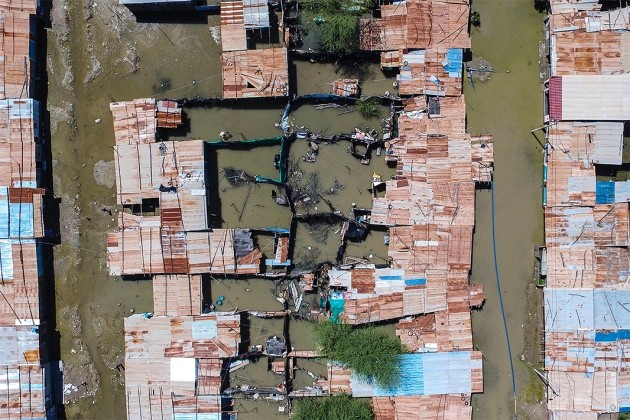Climate change casts a long shadow, and its impact falls heaviest on our cities.
With over half the world's population already residing in urban centres, a number projected to balloon to 68% by 2050 according to the United Nations, the urgency to adapt is paramount. This rapid urbanisation, particularly pronounced in developing countries across Asia, concentrates populations, economic hubs, and critical infrastructure in areas often highly susceptible to climate hazards.
The situation is particularly dire for coastal cities in low-lying Asian nations. A staggering 300 million people in Indonesia, Vietnam, Thailand, and the Philippines alone are expected to face devastating floods by 2050. Developed nations often possess more robust mitigation and adaptation strategies to combat these "sinking city" challenges. However, developing countries frequently lack the resources and expertise to tackle this existential threat. This disparity demands innovative solutions to build climate resilience in these communities, empowering them to not just survive, but thrive in the face of a changing climate.
But first, why the focus on communities?
While conventional approaches might prioritise constructing climate-resilient housing, infrastructure, or public services, these tangible solutions, though crucial, only address a fragment of the issue. Climate disasters, after all, impact people, not buildings.
Focusing solely on individual structures creates a web of vulnerability. If you reinforce your own house with hurricane shutters and storm-resistant materials, it's definitely more secure. However, if your neighbours’ house remains vulnerable with a leaky roof and weak walls, a strong storm could still devastate their property. In the aftermath, the debris from their damaged house could easily block access roads, hindering rescue efforts for everyone in the community, including yourself.
Therefore, building climate resilience isn't about erecting impenetrable walls against every eventuality; it's about empowering communities to weather the storm, together.
The necessity of building climate-resilient communities arises from a triple threat.
Firstly, the alarming speed of climate change is unlike anything humanity has faced in the past 10,000 years. While natural cycles have influenced climate fluctuations in the past, the current rapid warming trend is demonstrably driven by human activity since the mid-1800s. This rapid rise in global temperatures disrupts natural systems, leading to a cascade of effects – rising sea levels, warming oceans, and increasingly extreme weather events.
Secondly, climate change is an indiscriminate force – it is income agnostic. While wealthier cities may enjoy a temporary advantage in preparedness due to their deeper pockets, this advantage is a mirage in the long run. Everyone, from bustling metropolises to remote villages, needs to be prepared for the changing climate. This disparity, however, presents a unique opportunity for developing cities. Unburdened by the weight of legacy infrastructure, they have the chance to leapfrog outdated approaches and embrace innovative solutions.
Thirdly, strategies will vary depending on the specific vulnerabilities of each city. A coastal metropolis like Jakarta faces an existential threat from rising sea levels and intense storms. Here, investments in seawalls, flood defenses, and early warning systems are crucial. Conversely, a landlocked city like Bangalore might grapple with more frequent and severe heatwaves, necessitating urban cooling solutions like green roofs, strategic tree planting, and heat-resistant building materials.
By tailoring approaches to address the unique challenges of each location, communities can build targeted resilience for a more secure future.
So, how can private organisations join this crucial endeavour?
A recent programme we ran provides some insights. We brought a high-performing cohort of young leaders to Jakarta, a city facing existential climate threats. They interacted with vulnerable communities, civil society organisations (CSO), and think tanks, learning about successful cases of community resilience built on shared values and responsibilities.
This glimpse into the challenge revealed three key ways for private organisations to contribute.
Firstly, design initiatives that are inherently sustainable. Initiatives need to be both commercially viable and socially impactful. Move beyond one-off CSR gestures like handing out supplies after disasters. Businesses should examine their core operations and explore how sustainable practices can improve the lives of those most vulnerable to climate change. If you sell a product, can it empower communities? How can you then scale this impact for maximum benefit?
Secondly, empower, don't enable. Our natural instinct might be to simply donate to struggling communities. However, this approach can create a cycle of dependency, hindering long-term progress. Businesses need to re-imagine their role. True partnership goes beyond mere charity. It fosters a win-win situation where the company derives commercial value while simultaneously creating a positive social impact. Think co-creation. The key is to move away from a top-down, handout-based approach. Instead, empower communities to become active participants in building their own resilience.
Thirdly, collaboration is key. No company can solve this challenge alone. The current siloed approach, where businesses, governments, and CSOs operate in isolation, hinders progress. Effective solutions require collaboration on a grand scale. By combining resources, expertise, and perspectives, we can create a more holistic approach to building resilient communities. Governments can provide the regulatory framework and infrastructure, while CSOs bring their deep understanding of community needs. Businesses, on the other hand, contribute innovation, technology, and market expertise. The key is to leverage the unique strengths of each partner to create a collective force for positive change.
By following these guiding principles, private organisations can become transformative forces in building climate-resilient communities. This isn't just about short-term gains or mere box-ticking exercises in corporate social responsibility. It's about forging a future where businesses flourish alongside healthy, empowered communities.
This collaborative approach unlocks a wealth of benefits. Communities gain access to vital resources, expertise, and innovative solutions. Businesses discover new markets eager for sustainable products and services. Governments benefit from a more stable and prosperous society. Ultimately, we all breathe cleaner air, experience fewer climate-related disasters, and create a more equitable world for generations to come.


























